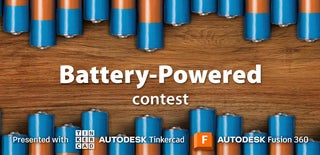Introduction: Thomson Ring - a Battery Powered Electromagnetic Ring Launcher
Faraday's famous law of induction states that when the magnetic flux changes in a conductor loop, an electrical voltage is induced. This electrical voltage then subsequently generates eddy currents. And these eddy currents also create a magnetic field. However, according to Lenz's law, this magnetic field is in the opposite direction to the magnetic field that caused it. Exactly this effect is used in the Thomson ring experiment (ring launcher).
Supplies
For this project you need the following parts:
- High Voltage module: link
- HV capacitors f.e. used for the camera flash: link
- Thyristors for the high-current switch: link
- a 100V or 1000V panel meter: link
- 1.4 mm enameled copper wire
- a large plastic housing, my housing has the dimensions 205 x 180 x 70 mm: link
- switch, which doesn't bounce. I have made good experiences with those from Multimec: link
- isolated florist wire, pin wire for the core: link
- 20 mm plastic tube: link
- 25x1.5 mm aluminum tube for the projectiles: link
Step 1: The Assembly
The individual capacitors have a capacity of 100 µF and a maximum charging voltage of 330V. I always connected two in series so that they can withstand a voltage of approx. 600V and then connected 27 of these pairs in parallel. So I get a total capacity of 1436 µF. With a charging voltage of 600 V, exactly the energy E = 1/2 * C * U² = 1/2 * 0.001436 * 600² = 258 J is stored in the capacitor bank.
So that the capacitors don't charge the wrong way after discharging (which can be very dangerous with electrolytic capacitors), I soldered two parallel P600K protection diodes. In the event of polarity reversal, these then short-circuit the capacitor bank.
For the projectiles I sawed rings about 1 cm high off the aluminum tube. These then weigh about 2-3 grams. The inner diameter must be only slightly larger than the outer diameter of the plastic tube. In my case the outer diameter of the plastic tube is 20mm and the inner diameter of the aluminum projectiles is 22mm. The plastic tube is then filled with the isolated florist wire, pin wire. The wires then conduct the magnetic field from the coil to the ring. However, they must be isolated so that there are as few eddy currents as possible. This would only consume energy unnecessarily.
I formed the coil from 1.4 mm enameled copper wire. I chose 66 turns.
To check the voltage across the capacitor bank I use a 100V panel meter. However, in order for it to be able to display voltages from 0 to 1000V, it needs a corresponding series resistor. The resistance of the panel meter is around 90 kOhm. For a 1:10 ratio, the series resistor must be 9 times as large, i.e. 9*90 = 810 kOhm. Then an applied voltage of e.g. 600 V is displayed with only 60V. The scale can then be supplemented with zeros without any problems.
The thyristors serve as high-current switches. A single thyristor can withstand a surge current of 300A. But this is not enough. Therefore I connected 8 of these thyristors in parallel. The peak current can be 2400 A. The gate control of the thyristors is very simple. For this purpose, a single 18650 Lion battery is connected to the gates via a button. So that the gate signals all arrive at the same time, I used cables of the same length for all gate connections.
The capacitor bank is charged via the high-voltage module. It is important to ensure that you use a module with a symmetrical output voltage, i.e. +/- 300V. This is the only way to provide voltages over 390V. The output voltage can be adjusted via a potentiometer. I use 600V for my setup because the capacitors can only handle a maximum voltage of 660V. Please turn the voltage on the potentiometer to a minimum first so that the maximum voltage is not present at the output. In the worst case, this can be 2 * 390V = 780V and thus already far too much for the capacitor bank! It is best to test the output voltage first without a capacitor bank and only connect the voltmeter to the HV module. Then you set the potentiometer to 600V, for example.
Caution: If the capacitor bank is then connected later, it is essential to ensure that you no longer touch the poles. There is danger to life, since the capacitors are charged to a voltage of 600V and have stored a lot of energy or can deliver a high current! So the greatest caution is required here. For protection, everything must later be housed in a plastic housing that is safe to touch.
The HV module is powered by 3 Lion batteries. These supply approx. 12V. I installed an ordinary switch between the batteries and the HV module so that I can switch off the HV module once the charging voltage has been reached.
Step 2: The Finished Setup
In my case, the case with dimensions of 200 x 180 x 70 mm was just enough to accommodate all components. When assembling, please do not install any rechargeable batteries and in any case leave the switch to the HV module open so that the capacitor bank is not charged! The batteries are only installed when everything is securely connected, and the switch to the HV module can only be closed when the housing is closed. Then the voltage on the voltmeter should not rise above 600V. For this purpose, the potentiometer on the HV module has been set correctly beforehand.
Now how do you deal with a shot? Well, you close the switch to the HV module and charge the capacitor bank to 600V. Then you open the switch again and shortly thereafter press the button to discharge the capacitor bank. If you have done everything correctly, the ring will quickly fly upwards.
For physics lessons you can then determine the speed of the ring. To do this, you record a video with a high-speed camera (e.g. an old Casio Exilim high speed is perfect for this purpose) and then later analyze it with the "Tracker" software (link). In my case I get a speed of 15 m/s = 54 km/h.
If you are interested in other exciting physics projects, you can find my Youtube channel and my homepage here:
In this sense, have fun experimenting and Eureka.

Participated in the
Battery-Powered Contest













